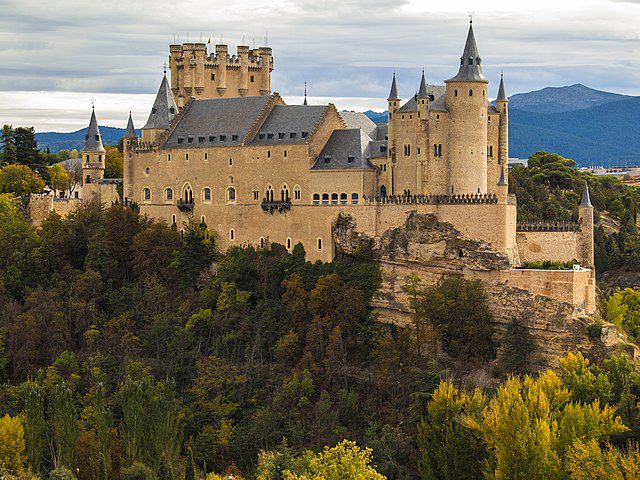
The Alcázar of Segovia is one of Spain’s most remarkable castles. Nestled in the historic town of Segovia, this fortress has stood for centuries, bearing witness to the country’s rich history. Its towering spires and majestic walls have inspired countless visitors and continue to do so today. The Alcázar is not just a relic of the past but a symbol of Spain’s architectural prowess and cultural heritage.
The history of the Alcázar is as captivating as its design. From its origins as a Roman fort to its transformation into a royal palace, the castle has evolved over the centuries. Each period in Spanish history has left its mark on the structure, contributing to its unique blend of architectural styles. Today, the Alcázar is a testament to the skill and creativity of the architects and builders who worked on it throughout the ages.
The Alcázar of Segovia’s significance goes beyond its architectural beauty. It has played a crucial role in Spain’s history, serving as a royal residence, a military academy, and a prison. Its walls have witnessed the rise and fall of kings and queens, as well as the battles that shaped the nation. The castle’s history is deeply intertwined with the story of Spain, making it an essential site for anyone interested in the country’s past.
The Alcázar’s impact on Spanish culture and architecture cannot be overstated. Its design has influenced other castles and buildings across the country, and its image has become a symbol of Segovia itself. The castle is also a popular tourist destination, attracting visitors from around the world who come to marvel at its beauty and learn about its history.
Historical Background of Alcázar of Segovia
The origins of the Alcázar of Segovia date back to Roman times. The site where the castle now stands was originally a Roman fort. This strategic location, perched on a rocky crag overlooking the Eresma and Clamores rivers, made it an ideal defensive position. The Romans recognized this and built a fort here to protect their interests in the region. Over the centuries, the fort underwent several transformations, eventually becoming the imposing castle we see today.
The castle’s evolution continued during the reign of Alfonso VIII in the 12th century. It was during this period that the Alcázar began to take on its current form. Alfonso VIII expanded and fortified the structure, making it one of the most important royal residences in Spain. The castle’s strategic location made it a valuable asset for the Spanish crown, and it quickly became a symbol of royal power.
Throughout the Middle Ages, the Alcázar of Segovia played a crucial role in Spain’s military and political affairs. The castle served as a royal residence for several Spanish monarchs, including Isabella I of Castile. It was here that she married Ferdinand II of Aragon, uniting the kingdoms of Castile and Aragon and paving the way for the creation of modern Spain. The castle also served as a military stronghold during the various conflicts that plagued the region.
In the 19th century, the Alcázar of Segovia was transformed once again, this time into a military academy. The castle’s defensive capabilities made it an ideal training ground for Spain’s future military leaders. The academy operated within the castle’s walls until a devastating fire in 1862. The fire destroyed much of the castle’s interior, but extensive restoration efforts in the following years restored the Alcázar to its former glory.
Architectural Design and Style
The exterior of the Alcázar of Segovia is a masterpiece of medieval architecture. The castle’s unique shape, resembling the bow of a ship, is one of its most distinctive features. This design is not only aesthetically pleasing but also served a practical purpose. The pointed shape allowed the castle to withstand attacks from all sides, making it an impregnable fortress. The castle’s exterior walls are made of stone, giving it a rugged, imposing appearance.
The castle’s towers are another striking feature of its exterior design. The most prominent of these is the Torre de Juan II, named after King John II of Castile. This tower stands at the highest point of the castle and offers breathtaking views of the surrounding landscape. The tower’s design is a blend of Gothic and Mudejar styles, reflecting the diverse cultural influences that have shaped the Alcázar over the centuries.
Inside the castle, the grandeur continues. The Alcázar’s interior is a stunning display of medieval craftsmanship. The castle’s grand hallways and rooms are adorned with intricate carvings and decorations, showcasing the skill of the artisans who worked on them. The Hall of the Kings is one of the most impressive rooms in the castle. This room is named after the series of statues that line its walls, each representing a different monarch from Spain’s history. The Throne Room is another highlight, with its ornate ceiling and lavish furnishings.
The Alcázar’s interior design is heavily influenced by the Mudejar style, a blend of Christian and Islamic architectural elements. This style is evident in the intricate patterns that decorate the castle’s walls and ceilings. The use of colorful tiles, known as azulejos, adds a vibrant touch to the castle’s otherwise austere interior. These decorative elements are a testament to the cultural diversity that has shaped the Alcázar throughout its history.
One of the most unique architectural features of the Alcázar is its roof. The steep, slate-covered roof is adorned with numerous pinnacles, giving the castle a fairy-tale appearance. These pinnacles were not just decorative; they also served a practical purpose. They helped to drain rainwater away from the castle’s walls, preventing damage to the structure. The roof’s design is a perfect example of how form and function can come together in architectural design.
The Alcázar’s courtyards are another key element of its design. The Patio de Armas is the largest of these courtyards and served as the castle’s main gathering place. Surrounded by high walls, the courtyard provided a secure space for the castle’s inhabitants to congregate. The Alcázar’s courtyards are simple in design, but they add to the overall sense of grandeur and majesty that pervades the castle.
Over the years, the Alcázar has undergone several restoration efforts to preserve its architectural splendor. These efforts have been essential in maintaining the castle’s structural integrity and ensuring that future generations can continue to enjoy its beauty. One of the most significant restoration projects took place in the late 19th century, following the devastating fire that destroyed much of the castle’s interior. Thanks to these efforts, the Alcázar remains one of Spain’s most iconic landmarks.
The Alcázar’s Influence on Spanish Architecture
The Alcázar of Segovia is a prime example of the Gothic and Mudejar styles that have played a significant role in Spanish architecture. These styles are characterized by their use of intricate patterns, pointed arches, and decorative elements. The Alcázar’s design incorporates all of these features, making it a quintessential representation of these architectural traditions. The castle’s blend of styles reflects the diverse cultural influences that have shaped Spain over the centuries.
The influence of the Alcázar’s design can be seen in other castles and buildings across Spain. The castle’s pointed arches and intricate patterns have inspired architects throughout the country. One notable example is the Alhambra in Granada, which also features a blend of Gothic and Mudejar styles. The Alcázar’s impact on Spanish architecture extends beyond castles; its design elements can also be found in churches, palaces, and other buildings throughout Spain.
The Alcázar of Segovia stands out even among Spain’s other famous castles. Compared to the Alhambra or the Alcázar of Toledo, the Segovia Alcázar has a unique charm. Its ship-like shape and stunning location make it one of the most picturesque castles in the country. While the Alhambra is known for its intricate Islamic art and the Toledo Alcázar for its military history, the Segovia Alcázar combines beauty and history in a way that few other castles can match.
The Alcázar’s influence is not limited to architecture. The castle has also had a significant impact on Spanish culture. Its image has become a symbol of Segovia and is often used in promotional materials for the city. The castle has also been featured in numerous films, books, and artworks, further cementing its place in Spanish cultural identity. The Alcázar’s architectural splendor and historical significance have made it an enduring symbol of Spain’s rich heritage.
The Cultural and Historical Impact of the Alcázar
The Alcázar of Segovia is more than just a beautiful castle; it is also a cultural icon. The castle has been featured in numerous films, television shows, and books, making it one of the most recognizable landmarks in Spain. Its fairy-tale appearance and historical significance have made it a popular setting for filmmakers and writers. The Alcázar’s image is often used to represent the romantic and mysterious side of Spain’s history.
The castle has also played a significant role in Spanish literature. It has been referenced in works by some of Spain’s most famous writers, including Miguel de Cervantes and Lope de Vega. These references have helped to solidify the Alcázar’s place in the country’s cultural consciousness. The castle’s association with Spain’s literary giants has only added to its allure and mystique.
The Alcázar of Segovia is not just a cultural icon; it is also a major tourist destination. Every year, thousands of visitors flock to the castle to experience its beauty and learn about its history. The castle’s status as a UNESCO World Heritage site has only increased its popularity. Visitors to the Alcázar can explore its grand halls, climb its towers, and enjoy the stunning views of the surrounding landscape.
The Alcázar’s impact on tourism is not limited to Segovia. The castle has become a symbol of Spain as a whole, attracting visitors from all over the world. The revenue generated by tourism to the Alcázar has had a positive impact on the local economy, providing jobs and supporting businesses in the area. The castle’s popularity shows no signs of waning, as more and more people are drawn to its architectural beauty and historical significance.
The Alcázar’s Role in Modern Spain
Today, the Alcázar of Segovia serves a variety of functions. The castle is primarily a museum, offering visitors a glimpse into Spain’s rich history. The museum’s exhibits cover a wide range of topics, from the castle’s architectural evolution to its role in Spanish military history. The Alcázar also hosts temporary exhibitions, showcasing art, artifacts, and historical documents related to the castle and the city of Segovia.
In addition to its role as a museum, the Alcázar is also used as a venue for cultural events. The castle’s grand halls and courtyards provide a stunning backdrop for concerts, exhibitions, and other events. These events help to keep the castle relevant in modern Spain, attracting visitors who might not otherwise be interested in history. The Alcázar’s ability to adapt to modern needs while preserving its historical integrity is a testament to its enduring appeal.
Preserving the Alcázar for future generations is an ongoing challenge. The castle’s age and the natural wear and tear caused by weather and tourism mean that regular maintenance is essential. The Spanish government, along with various cultural organizations, is committed to preserving the Alcázar’s architectural splendor. This commitment is evident in the extensive restoration projects that have been carried out over the years, as well as in the ongoing efforts to protect the castle from further damage.
Looking to the future, there are plans to continue these preservation efforts and to further enhance the visitor experience at the Alcázar. This includes improving the museum’s exhibits, offering more interactive experiences, and expanding the range of events held at the castle. These efforts will ensure that the Alcázar remains a vibrant and vital part of Spain’s cultural landscape for years to come.
Conclusion
The Alcázar of Segovia is a true architectural marvel. Its unique design, rich history, and cultural significance make it one of Spain’s most important landmarks. The castle’s blend of Gothic and Mudejar styles, its role in Spain’s military and political history, and its enduring impact on Spanish culture and architecture all contribute to its status as a national treasure. Visitors to the Alcázar are not just exploring a beautiful castle; they are stepping into a piece of Spain’s history.
The Alcázar’s future looks bright, thanks to ongoing preservation efforts and its continued popularity as a tourist destination. The castle’s ability to adapt to modern needs while maintaining its historical integrity is a testament to the skill and dedication of those who care for it. As one of Spain’s most iconic landmarks, the Alcázar of Segovia will continue to inspire and captivate visitors for generations to come.
As Spanish philosopher José Ortega y Gasset once said, “History is the product of great decisions.” The Alcázar of Segovia stands as a testament to the great decisions made by the architects, builders, and leaders who shaped its history. Their legacy lives on in the castle’s walls, towers, and courtyards, reminding us of the power of human creativity and ingenuity.




